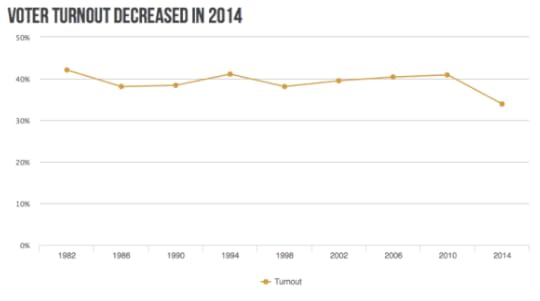Andrew Sullivan's Blog, page 102
November 7, 2014
Oh Deer
They’re hot to trot this time of year, and that means trouble for motorists:
On average, 2 million deer-vehicle collisions occur yearly, costing more than $4 billion in vehicle damage. About 5% of those collisions involve human injury, and sometimes deaths. Most of those collisions happen in November because deer are on the move, looking for a hook-up. As days get shorter, male testosterone production increases. Fall is rut season, and male deer roam widely in search of females. If you’re driving at dusk or dawn in November, you’re on a Highway to the Danger Zone: the majority of deer collisions happen this month. The average cost of a deer-vehicle collision is $8,388, and $30,773 for a moose-vehicle collision.
(Photo by Fabrice Florin)









Longing For The Caliphate
Shadi Hamid offers his take on what attracts people to ISIS, and why that attraction is specific to Islam:
ISIS draws on, and draws strength from, ideas that have broad resonance among Muslim-majority populations. They may not agree with ISIS’s interpretation of the caliphate, but the notion of a caliphate—the historical political entity governed by Islamic law and tradition—is a powerful one, even among more secular-minded Muslims. The caliphate, something that hasn’t existed since 1924, is a reminder of how one of the world’s great civilizations endured one of the more precipitous declines in human history. The gap between what Muslims once were and where they now find themselves is at the center of the anger and humiliation that drive political violence in the Middle East. But there is also a sense of loss and longing for an organic legal and political order that succeeded for centuries before its slow but decisive dismantling. Ever since, Muslims, and particularly Arab Muslims, have been struggling to define the contours of an appropriate post-caliphate political model.
In contrast, the early Christian community, as Princeton historian Michael Cook notes, “lacked a conception of an intrinsically Christian state” and was willing to coexist with and even recognize Roman law. For this reason, among others, the equivalent of ISIS simply couldn’t exist in Christian-majority societies. Neither would the pragmatic, mainstream Islamist movements that oppose ISIS and its idiosyncratic, totalitarian take on the Islamic polity. While they have little in common with Islamist extremists, in both means and ends, the Muslim Brotherhood and its many descendants and affiliates do have a particular vision for society that puts Islam and Islamic law at the center of public life. The vast majority of Western Christians—including committed conservatives—cannot conceive of a comprehensive legal-social order anchored by religion. However, the vast majority of, say, Egyptians and Jordanians can and do.









The Demographic Party
Ed Morrissey interprets the exit polls’ breakdown of the electorate, particularly in terms of their implications for the GOP going into the next election cycle:
The GOP made slight gains in 2014 over 201o among blacks, 18-29YOs, the middle class, and a large jump among Asian-Americans. They lost ground among women, Latinos, independents, seniors and 30-44YOs, and both working class and the wealthy. None of these declines went into double digits, but aside from the income demos, they all exceed the margin of error in the polling.
Kilgore focuses on what Democrats will need to do to recapture their key demos in 2016:
[A]nother way to look at it is that minority voting preferences are returning to their pre-Obama level — still strongly Democratic, but not so strongly that in a poor turnout year they offset the heightened Republican preferences of white voters. … What are the implications, then, for the election cycle we have just entered? Some of the Republican advantage can be expected to melt away instantly due to the age and race/ethnicity differential for a presidential cycle. That shift will apply to downballot races as well. So a more favorable-to-Democrats electorate will vote on a Senate landscape as difficult for Republicans as this year’s was difficult for Democrats. The GOP will need all those wins from yesterday to survive Election Night in 2016 with a majority intact.
But more generally, and with respect to the presidential election itself, the big question is whether Barack Obama’s successor can recapture his extraordinarily high vote percentages among young and minority voters, and/or make inroads among the older and whiter voters who have now consistently rebuffed him and his party in three straight cycles.
Putting demographics aside, Sean Trende calls the election a victory for the fundamentals model:
Back in February of this year, I put together a simple, fundamentals-based analysis of the elections, based off of nothing more than presidential job approval and incumbency. That was it. It suggested that if Barack Obama’s job approval was 44 percent, Republicans should pick up nine Senate seats. Obama’s job approval was 44 percent in exit polls of the electorate, and it appears that Republicans are on pace to pick up nine Senate seats. Moreover, only one Democrat — Natalie Tennant in West Virginia — ran more than 10 points ahead of the president’s job approval.









Artificial Obtuseness
Kevin Kelly believes the A.I. of the future might require built-in intellectual blinders:
Most of the commercial work completed by AI will be done by special-purpose, narrowly focused software brains that can, for example, translate any language into any other language, but do little else. Drive a car, but not converse. Or recall every pixel of every video on YouTube but not anticipate your work routines. In the next 10 years, 99 percent of the artificial intelligence that you will interact with, directly or indirectly, will be nerdily autistic, supersmart specialists.
In fact, this won’t really be intelligence, at least not as we’ve come to think of it. Indeed, intelligence may be a liability – especially if by “intelligence” we mean our peculiar self-awareness, all our frantic loops of introspection and messy currents of self-consciousness. … As AIs develop, we might have to engineer ways to prevent consciousness in them – and our most premium AI services will likely be advertised as consciousness-free.









November 6, 2014
The Best Of The Dish Today
If you want evidence of the lack of enthusiasm for this week’s election or of the success of the GOP’s efforts to suppress voting among minorities and the young, it’s right there above. Click the link for state-by-state data. It’s worth remembering this very low turnout in the context of Republican triumphalism. They better not over-estimate their mandate.
Today, I took another solid whack at the emptiness of the GOP’s non-agenda, but questioned whether the president’s declared intent to go ahead with executive actions on immigration is the best opening salvo for his final two years.
I also doubted that the re-elected Scott Walker really has what it takes to be presidential material. Many readers – from Wisconsin and elsewhere – told me to look more closely:
Don’t make the mistake of underestimating Scott Walker, like Wisconsin Democrats have been doing for years. He’s canny as hell and has a gift for packaging severe conservatism inside bland affability. Walker raises money with no problem, connects with both wings of his party, and has spent the last five years winning three elections within a perpetual campaign. Nobody in the Republican field has his combination of trial and success.
Imagine it’s late February 2012, Tim Pawlenty hasn’t dropped out, and the “anybody but Mitt” crowd has a plausible alternative to the Bible-thumper and the whore. Now imagine that behind Pawlenty’s down-to-earth Midwestern exterior lies a merciless political mind and an unshakeable will. That’s Scott Walker. Would Obama have been re-elected so easily? Or at all?.
Another:
Speaking as a Wisconsinite who is no fan of Walker, I have to say it’s perilous to underestimate this guy. All he does is win. No one thought he could possibly be governor when he first ran, and he won. Apparently, there was similar sentiment in Milwaukee when he ran, and was elected for, county executive. And he’s unwavering in his commitment to his conservative positions. He’s almost disconcertingly ideologically pure.
And he’s Teflon. Nothing seems to stick to him. He promised to create 250000 jobs under his administration in 2010. By all accounts, not even half of that number have been created. Wisconsin has lagged behind most other states in our region in economic growth. He dismantled the state Dept. of Commerce and replaced it with the public/private Wisconsin Economic Development Corporation, which has been beset with issues. Multiple members of his campaigns have been indicted. But he just keeps trucking along, seemingly unscathed. And he’s very skilled at calmly stoking the rural/suburban resentment towards perceived urban elites.
Seriously, the uncharitable side of me wants someone to check under his hair for a birthmark. But the pragmatist in me grudgingly has to give him credit for his ability to win and win and win.
Points well taken. One other post worth revisiting: why detente with Iran is easily the most significant and vital part of Obama’s agenda as he cements his legacy – and things just got a nudge forward.
The most popular post of the day was Where Did Obama Go Wrong? followed by A Victory For What?
Many of today’s posts were updated with your emails – read them all here. You can always leave your unfiltered comments at our Facebook page and @sullydish. 22 more readers became subscribers today. You can join them here – and get access to all the readons and Deep Dish – for a little as $1.99 month. Gift subscriptions are available here. Dish t-shirts are for sale here, including the new “Know Dope” shirts, which are detailed here.
See you in the morning.









Is The “War On Women” Over?
Wow. “War on women” messaging *really* failed in Colorado. Lowest turnout by women since 1992: http://t.co/QUl7I6G5Ki
— Matt Yglesias (@mattyglesias) November 5, 2014
Reviewing some of the Democratic delusions shattered by Tuesday’s election results, Byron York remarks on how thoroughly the Democrats’ effort to paint the GOP as fundamentally hostile to women flopped:
There were times when the midterm Senate campaigns seemed entirely devoted to seeking the approval of women voters. The Udall campaign in Colorado was almost a parody of such an appeal to women, focusing so extensively on contraception and abortion that the Denver Post called it an “obnoxious one-issue campaign.” Beyond Udall, most Democrats hoped a gender gap would boost them to victory. As it turned out, there was a gender gap in Tuesday’s voting, but it favored Republicans. Exit polls showed that Democrats won women by seven points, while Republicans won men by 13 points. The numbers are definitive proof that, contrary to much conventional wisdom, Democrats have a bigger gender gap problem than the GOP. The elections showed precisely the opposite of what Democrats hoped they would.
Matt Lewis hopes this defeat marks the end of that scare tactic:
The war on women meme was always a farce to begin with. Republicans are moms, sisters, and wives. The attack rings especially hollow in a year when Republicans have elected so many firsts. West Virginia Rep. Shelley Moore Capito and Iowa’s Joni Ernst, for example, will both become the first female senators ever elected from their respective states. New York’s Elise Stefanik last night became the youngest woman ever elected to Congress. And Utah’s Mia Love became the first Haitian-American member of Congress. I could go on…
But Ramesh doubts Democrats will give it a rest:
Gardner’s win and Ernst’s likely win won’t end this campaign tactic, because Democrats figure that it motivates low-propensity voters to show up–and therefore will assume it will work better in 2016. The tactic will have to be seen to fail in a presidential year before they will abandon it.
Marcotte blames the failure of the “war on women” talking point on the war on women itself, noting that the GOP’s 64 percent share of the white men’s vote was their widest advantage among that demographic in 30 years. That was no accident, she argues:
[I]f you turned on conservative media, you heard a much different story than the cautious moderation that actual Republican politicians were trying to sell. Conservative outlets spent the past few months really ramping up the narrative of poor, put-upon white men who are under attack by women. Or, more specifically, single women. A small sampling: Tucker Carlson of Fox News complaining that the country needs “Older White Guy Appreciation Day.” Rush Limbaugh claiming there’s an “all-out assault” on marriage from liberals and suggesting that single women need to be married off so they stop voting for Democrats. Kimberly Guilfoyle of Fox News arguing that single women are too busy being “healthy and hot and running around without a care in the world” to handle civic duties like voting and jury duty properly and therefore should busy themselves with “Tinder or Match.com” instead.
In addition to securing the female vote, this line of attack was supposed to help turn out young voters for the Democrats, but it didn’t do that either. Elizabeth Nolan Brown wonders if they might have had more success with Millennials if they had run on a broader youth-focused platform:
I’d love to be able to peer into some alternate reality where Democrats like Udall had campaigned on opposition to CIA torture and NSA spying; or had attempted to motivate their minority bases by focusing on issues like those coming out of Ferguson, Missouri; or had hitched their wagon to marijuana legalization in states where it was on the ballot. These are some of the issues that matter most right now to young voters …
Could campaigns that emphasized opposition to civil-liberties abuses, police brutality, and drug criminalization have captured more ballot-box love from millennials? As we’ve seen in poll after poll—from Harvard’s to Pew Research Center’s to our own here at Reason—millennials are massively dissatisfied with traditional partisan options and more likely than any young cohort previously to consider themselves political independents. And those issues are ones not necessarily beholden to a natural partisan divide. A Republican or a Democratic candidate who ran with them could well capture post-party, post-Hope millennial passions (along with older independents, too, of course).









Face Of The Day
Tens of thousands of protesters swarmed outside the Attorney’s office in Mexico City to demand the safe return of 43 missing students after authorities arrested the main suspects in the disappearance. By Ronaldo Schemidt/AFP/Getty Images.









One America, Two America, Red America, Blue America
Yglesias comes to the conclusion that American politics is trapped in a “demographically driven seesaw”:
The presidential and non-presidential electorates look too different for either political party to optimize for both of them. Democrats have built a coalition that’s optimized for presidential years, while the GOP has one that’s optimized for off-years. And so we’re set for a lot of big swings back and forth every two years.
Douthat reminds everyone that “all of this is, in part, a political choice on the part of the people responsible for shepherding our two political coalitions”:
Clintonism and Bushism were both attempts, even if not always successful, to build or maintain coalitions that weren’t locked into boom-bust cycles, and that included a kind of internal diversity that could be sustained across presidential and non-presidential elections. (As, on a more limited scale, was Howard Dean’s fifty-state strategy in the non-seesaw year of 2006.) There are solid-enough structural reasons why that internal diversity has faded since — the aging-out of New Deal seniors has made older voters more reliably conservative, their Iraq-related disillusionment with Bush and their changing patterns of social life have made younger voters more reliably liberal, the growth of the Hispanic vote has changed incentives for both parties, the presidency of Barack Obama has furthered racial polarization in unfortunately-predictable ways.
But it’s also faded because elites in both parties have been happy to see it fade — because a lot of liberal elites don’t want to make the kind of compromises that would keep their party a little more viable in midterms with, say, some of the white Southerners or Midwesterners who voted for Bill Clinton, and because a lot of conservative elites would rather lose presidential elections while talking about the 47 percent and upper-bracket tax cuts than win them while making the kind of shifts on economic issues that might win more presidential-cycle votes from the downscale or disaffected. (And of course there are still other organizing options, libertarian and socialist and so on, that are even further afield from what party elites prefer.) And those choices, while understandable and in some sense structurally-driven themselves, are still choices, which other choices could alter or undo.









The View From Your Window
Marriage Equality Heads Back To SCOTUS?
Dale Carpenter marks today’s big marriage equality news:
By a 2-1 vote, with Judge Jeffrey Sutton writing the opinion, the Sixth Circuit has upheld state prohibitions on same-sex marriages in the states of Ohio, Kentucky, Michigan, and Tennessee. Given that four other circuits have come out the other way, and that same-sex marriages are proceeding in 32 states, this is the case that produces the circuit split likely to be resolved by the Supreme Court. If petitions for certiorari are filed soon, as I expect they would be, we could still be on track for argument this Term and decision by the end of June 2015.
Lyle Denniston explains that the “challengers in the cases in the four states of the Sixth Circuit now have two legal options”:
First, they can ask the full Sixth Circuit bench (the en banc court) to reconsider their cases, and if the court does that, then the panel decision released Thursday would be wiped out and the en banc court would start fresh. The loser at that level could then seek Supreme Court review.
Second, the challengers can now move directly to the Supreme Court; they do not have any legal obligation to seek further review in the Sixth Circuit Court. If they take that path, it would be up to the Justices to decide for or against review, and it would take the votes of only four of the nine Justices to agree to hear the case.
One of the key arguments in the ruling:
When the courts do not let the people resolve new social issues like this one, they perpetuate the idea that the heroes in these change events are judges and lawyers. Better in this instance, we think, to allow change through the customary political processes, in which the people, gay and straight alike, become the heroes of their own stories by meeting each other not as adversaries in a court system but as fellow citizens seeking to resolve a new social issue in a fair-minded way.
Mark Joseph Stern pounces on this passage:
Sutton, a George W. Bush appointee, had described these concerns during oral argument last August, and they clearly guided his vote here. Predictably, Sutton also harps upon the brief portion of United States v. Windsor that dealt with states’ rights—while largely overlooking its concern with the dignity of gay people. In Windsor, the court held that a federal gay marriage ban “degrade[s],” “demean[s],” and “disparage[s]” gay people. Yet Sutton is unconcerned that gay marriage bans might “demean” gay people; rather, he frets that overturning such a ban would be “demeaning to the democratic process.”
Howard Wasserman further unpacks Judge Sutton’s ruling:
Say this: Sutton hit every possible argument and issue surrounding marriage equality (although he soft-pedaled his discussion of the “marriage is for men and the women they accidentally knock-up” argument). So the opinion presents a good vehicle for thorough consideration (and reversal).









Andrew Sullivan's Blog
- Andrew Sullivan's profile
- 153 followers















